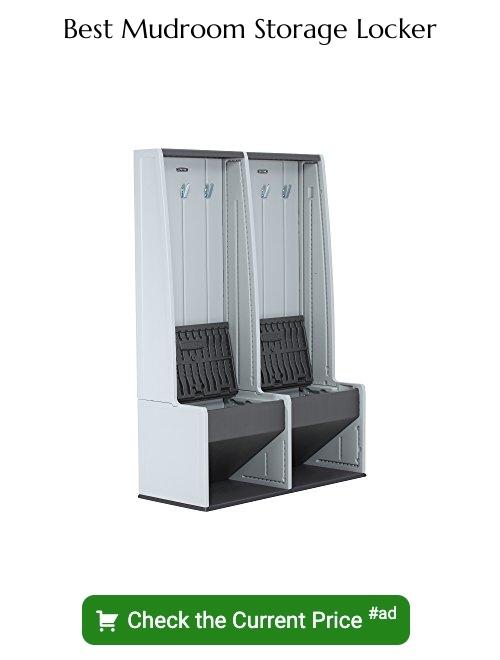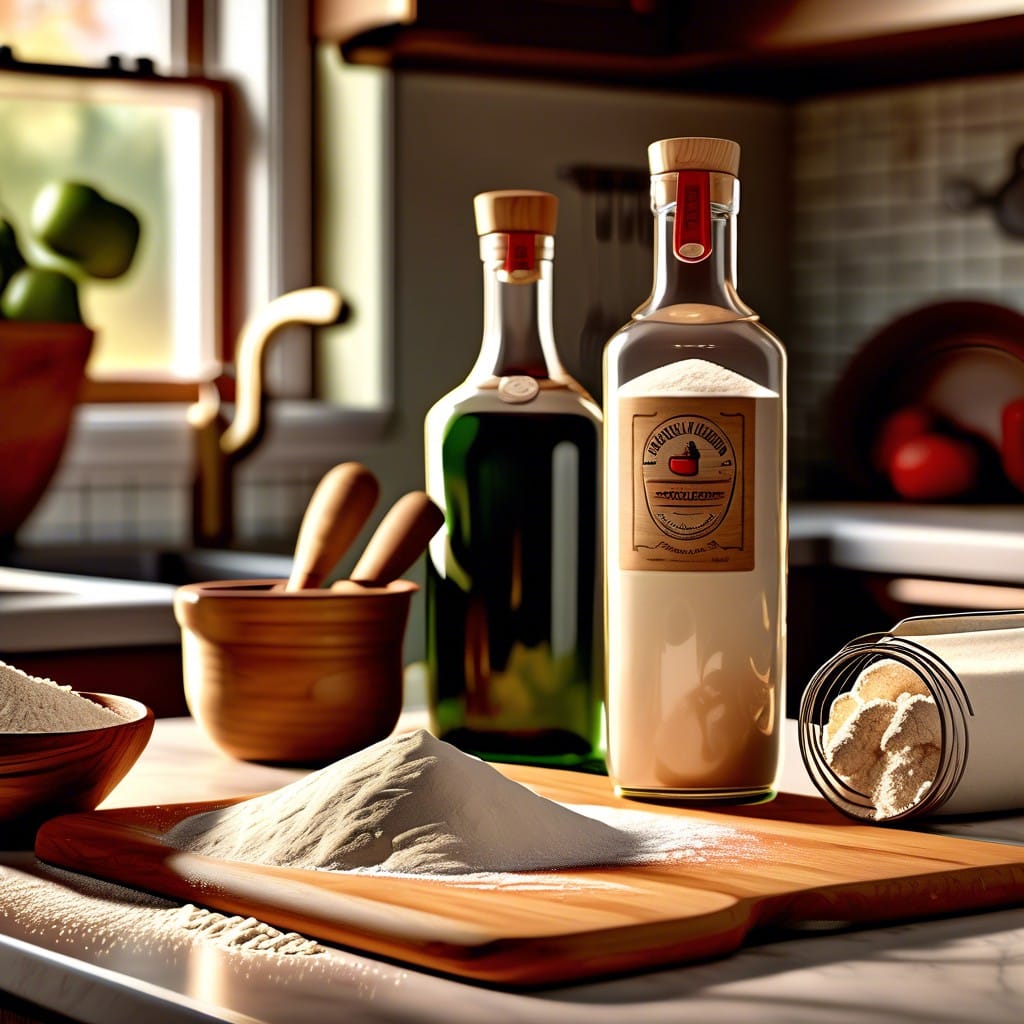Last updated on
Finding the perfect mudroom locker dimensions matters because it can turn your cluttered entryway into a functional, organized space.
Key takeaways:
- Standard mudroom lockers are 24 inches deep and 12-18 inches wide per unit.
- Heights can vary depending on ceiling clearance and storage needs.
- Consider lower hooks and lockers for children’s use.
- Locker construction: strong frame, customization, ventilation, backing material, shelving, hooks, and rods.
- Required tools: tape measure, level, drill, screwdriver, saw, clamps, and pencil.
Dimensions for the Mudroom Locker
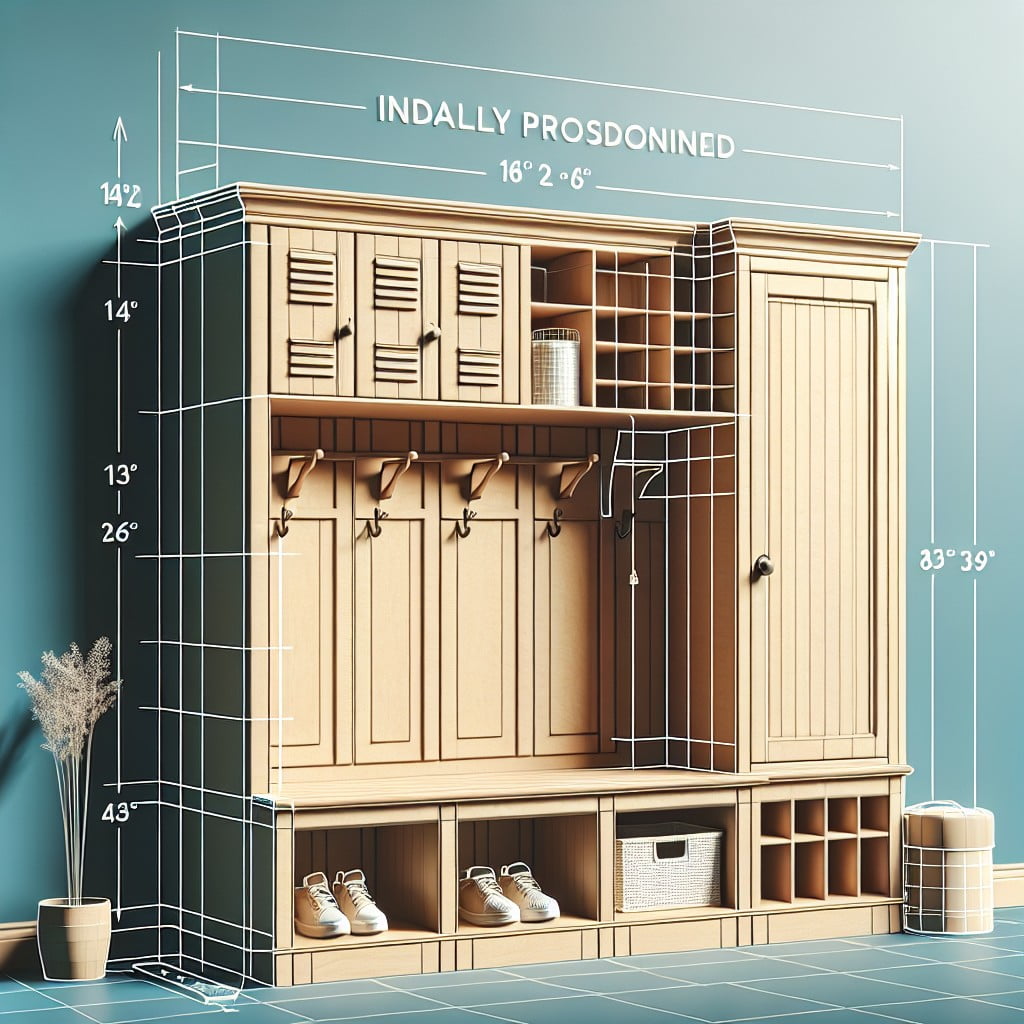
Standard mudroom lockers are typically 24 inches deep, allowing for plenty of storage without intruding excessively into the room. The width usually ranges from 12 to 18 inches per locker unit, providing adequate space for most coats and backpacks.
Heights can vary greatly depending on ceiling clearance and storage needs, though a common measurement is 72 inches, offering sufficient room for hanging items. Keep in mind, however, that custom lockers can be tailored to any dimension to fit specific room configurations and storage requirements.
For households with children, consider installing lower hooks within their reach, and allocating lower lockers or cubbies for their use. When determining locker widths, factor in the number of family members and the types of items stored to ensure a functional space tailored to your lifestyle.
Locker Construction for the Mudroom Locker
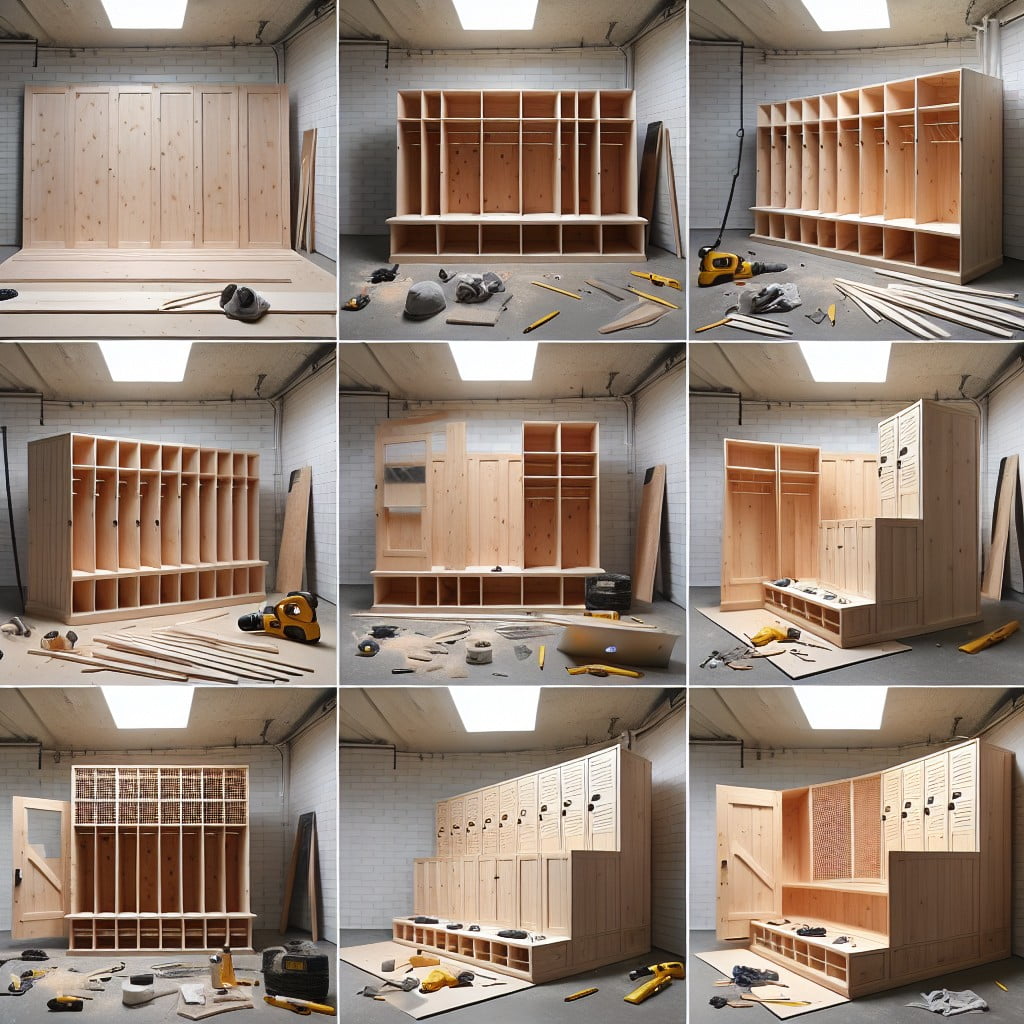
Constructing a mudroom locker begins with a detailed plan to outline the desired number, size, and features of each unit. When building, consider the following points:
- Frame Strength: Ensure the frame is constructed of sturdy material able to withstand daily use. Plywood or solid wood are common choices for their durability.
- Customization: Adjust the locker dimensions based on the space available and intended storage use—allocate space for hanging coats, storing shoes, and placing bags.
- Ventilation: Provide ventilation within the locker design to allow items to air out and prevent mildew or odor buildup.
- Backing material: Choose a backing material, like beadboard or plywood, for additional support and aesthetic appeal.
- Fixed or Adjustable Shelving: Decide between fixed shelves for stability or adjustable shelving for flexibility in storage options.
- Hooks and Rods: Install hooks at strategic heights for hanging various items and a rod for items on hangers if space permits.
By focusing on these key aspects, the resulting lockers will be functional, durable, and tailored to specific storage needs.
Required Tools
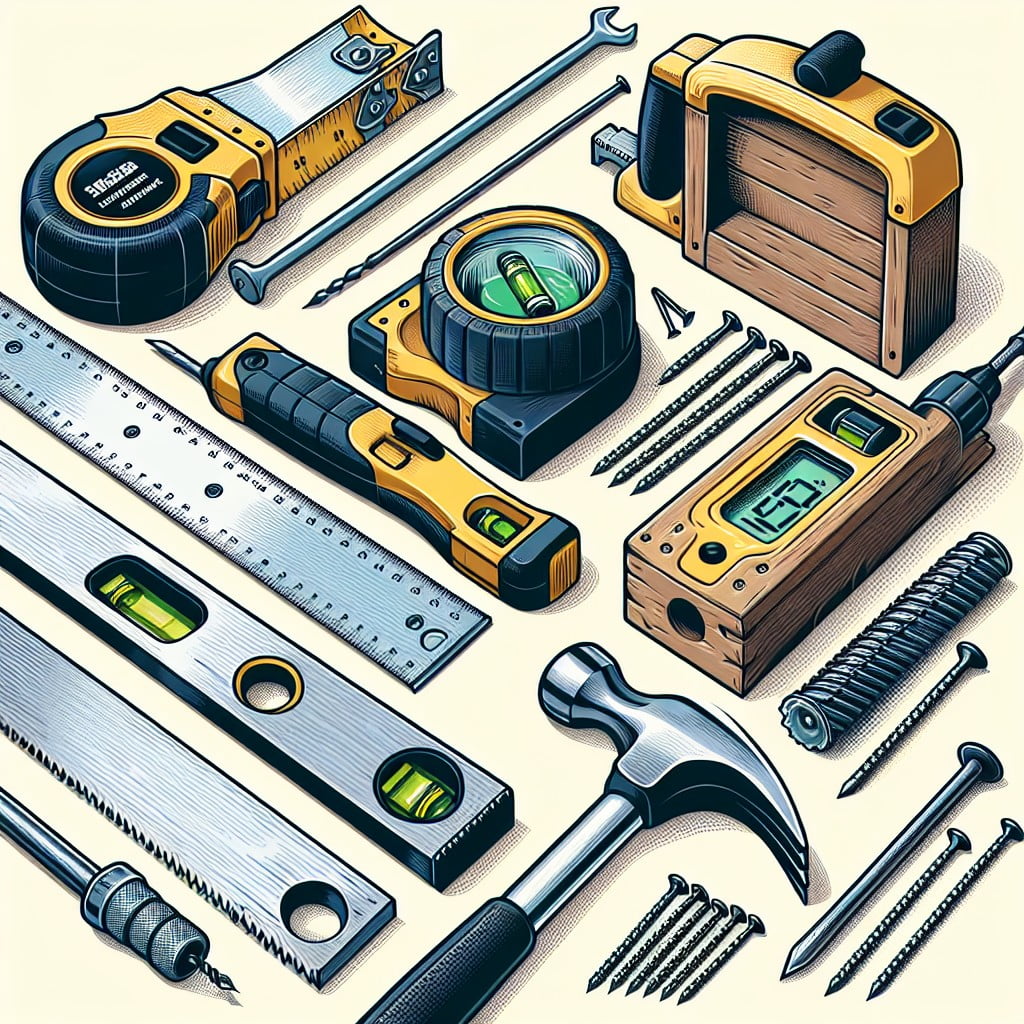
To construct your mudroom lockers, you will need a set of basic tools. Ensure you have a tape measure for accurate dimensions, a level to keep everything straight, and a drill for assembling parts. You’ll also need a screwdriver, preferably a powered one to save time and effort. A saw is necessary to cut your materials to the right size—either a handsaw for manual work or a power saw for efficiency. Lastly, clamps can be very helpful to secure pieces as you work, and a pencil for marking measurements and cut lines is essential. Gather these tools before you start building to streamline the construction process.
Materials

Selecting the right materials is crucial for constructing durable and aesthetically pleasing mudroom lockers. High-quality plywood, typically ¾-inch, serves as a sturdy base for the structure. For areas that will bear more weight, such as the seat of the bench, consider using hardwood for added strength.
A moisture-resistant MDF can be a good option for the back panel, as it will withstand the damp items often stored in mudrooms. To complement the wood, solid metal hardware is recommended for hinges and hooks, ensuring longevity. If you’re planning to add a personal touch with paint or stain, choose products designed for high traffic areas for finish longevity.
Remember, the materials chosen will directly impact the locker’s durability and maintenance needs over time.
Preparation
Before diving into construction, ensure you have clear, accurate measurements of your mudroom space to tailor the locker system appropriately. A common height for mudroom lockers is around 72 inches, allowing enough room for hanging coats. The width can range between 12 to 18 inches per locker section, with a depth of 15 to 24 inches, providing ample storage without encroaching too much into the walkway. It’s crucial to take into account any features like baseboards, moldings, or outlets that could influence the design. Use painter’s tape to outline the dimensions on the wall to visualize the final setup and adjust as needed. Additionally, consider ventilation for areas that will store shoes or wet clothing to keep the space fresh.
Install the Lockers
Once the locker frames are assembled, ensure they are securely attached to both the wall and the floor for stability. Begin by finding the wall studs using a stud finder. Mark the stud locations on the wall and align the lockers accordingly. Use heavy-duty screws to fasten the lockers to the wall studs at both the top and the bottom of the locker unit.
Next, check that the lockers are level both horizontally and vertically. This can be done using a level. Adjust as necessary by adding shims under the lockers or behind them at the screw points to ensure that they are perfectly vertical and sit flush against the wall.
If the locker design includes a base or kick plate, install this prior to securing the lockers to the wall. The kick plate not only hides shims and gaps but also gives the locker a finished look and contributes to its overall rigidity.
Once anchored to the wall, connect adjacent lockers to one another if applicable. Predrill holes and use cabinet screws to join the units together, ensuring that the faces are flush and the edges are aligned neatly. This step is crucial for creating a uniform appearance and for the structural integrity of the mudroom locker setup.
Finally, cap the installation process by attaching any trim or molding as designed. This includes baseboard molding, crown molding, or any decorative trim that will conceal seams and provide a polished finish to your locker setup.
Sanding & Sealing
Once the lockers are assembled, it’s crucial to move on to finishing touches to ensure longevity and a smooth appearance. Starting with a coarse-grit sandpaper, sand down the entire wooden surface to remove any rough spots or splinters. Progress to a finer grit to achieve a silky texture. Dust off the residues with a tack cloth to prepare for sealing.
Sealing is essential—it protects the wood from moisture and wear, which is particularly important in a mudroom environment. Apply a wood sealant using a natural-bristle brush, coating evenly to prevent drips and ensure deep penetration into the wood. Allow the first coat to dry as per the manufacturer’s instructions. For added durability, consider a second coat, gently sanding between layers with a very fine sandpaper to maintain a polished surface. Remember to work in a well-ventilated area and use protective gear when working with sealants.
Pull Out Shoe Shelves
Pull out shoe shelves are an innovative storage solution designed to maximize space and organization in mudroom lockers. They allow for easy access to shoes while keeping them tucked away when not in use.
Here are some key points to consider when incorporating pull out shelves into your mudroom locker design:
- Customizable Width: These shelves can be customized to fit the exact width of your locker, typically ranging from 24 to 36 inches, to accommodate multiple pairs of shoes side by side.
- Depth Specifications: A standard depth of 12 to 16 inches ensures that even larger shoes have ample space without protruding from the locker.
- Height Adjustments: Consider adjustable mounting systems to accommodate varying shoe heights—allow for at least 6 inches of vertical space for average shoes and up to 8 inches for boots.
- Durable Slides: Select heavy-duty slides that can support the weight of the shoes and withstand frequent use.
- Easy-to-Clean Materials: Choose materials like metal or plastic for the shelves, which are easy to wipe down and resistant to dirt and moisture from shoes.
- Ventilation: Opt for shelves with a grated design or perforations to provide airflow, which helps in keeping shoes dry and minimizing odor.
- Locking Mechanism: A soft-close or locking mechanism can prevent the shelves from slamming and ensure they stay closed as you walk by.
By integrating these customizable pull out shoe shelves into your mudroom lockers, you can elevate the functionality of your mudroom and enjoy a clutter-free, organized entryway.
Mudroom Bench With Locker Hutch
Integrating a bench with your locker hutch is both stylish and functional, adding a practical seating area to your mudroom. When considering dimensions, aim for a bench height of 17 to 19 inches, which aligns with the standard sitting height for most people. The bench depth should ideally be between 15 to 18 inches, ensuring enough room to sit comfortably without obstructing the flow of traffic.
The length of the bench will typically match the span of the locker unit but can extend beyond to provide additional seating. For the hutch above, allocate enough space between the bench and the first shelf or hooks—around 48 to 50 inches—to hang coats without them touching the bench.
Incorporate storage beneath the bench, such as pull-out drawers or baskets, an excellent solution for stowing shoes and seasonal items. The locker hutch above should have compartments for each family member, with a width of about 12 to 18 inches per section, providing ample space for personal belongings. Shelving within the hutch can be adjustable to accommodate items of various sizes, ensuring a customizable and versatile storage solution.
Open Bench and Hutch
Incorporating an open bench paired with a hutch into your mudroom locker design offers both accessibility and efficient use of space. This combination allows for easy and quick seating when removing shoes, while the hutch provides ample storage overhead.
Factors to consider when determining dimensions include:
- Bench Height: Aim for a comfortable seating height, typically between 17 and 19 inches, to accommodate both children and adults.
- Bench Depth: Plan for a depth of at least 18 inches to ensure there’s enough space to sit down without feeling cramped.
- Hutch Shelving: Leave about 10-12 inches of space between shelves to store everyday items and consider adjustable shelving to accommodate items of varying heights.
- Width Per Section: Design each locker section to be between 18 and 24 inches wide to provide personal space for hanging coats and storing bags.
- Overall Height: Ensure the total height of the bench and hutch does not exceed seven feet, making the top storage accessible for most adults without needing a step stool.
Remember, these dimensions can be customized to suit individual needs, considering the room’s size and the users’ specific requirements.
FAQ
What size should mudroom lockers be?
Mudroom lockers should ideally measure 16.75 inches in width, 22.5 inches in depth, and 71 inches in height for optimal usage.
What size is a mud closet?
A mud closet, as part of a mudroom, should ideally follow the 20-foot-per-person rule, which in practice means that it could be around 15′ x 7′ or 12′ x 10′ for a five-person family, depending on the layout of the home and storage plans.
How big should cubbies be?
For optimal storage, the dimensions of a cubby should be at least 12 to 18 inches in depth.
What are the dimensions of a mudroom bench?
A mudroom bench should ideally have a depth of 15.25" or 20.25", a height of 17.25", with the width of each bay kept under 36".
What is the ideal shelf height in a mudroom locker?
The ideal shelf height in a mudroom locker should be approximately 16 to 20 inches to comfortably accommodate varying boot and shoe sizes.
How wide should individual compartments in mudroom lockers be?
Individual compartments in mudroom lockers should ideally be 15-20 inches wide to accommodate various items like coats, backpacks, and shoes.
What is the optimal depth for mudroom cubbies?
The optimal depth for mudroom cubbies is typically between 12-16 inches.
Recap:
